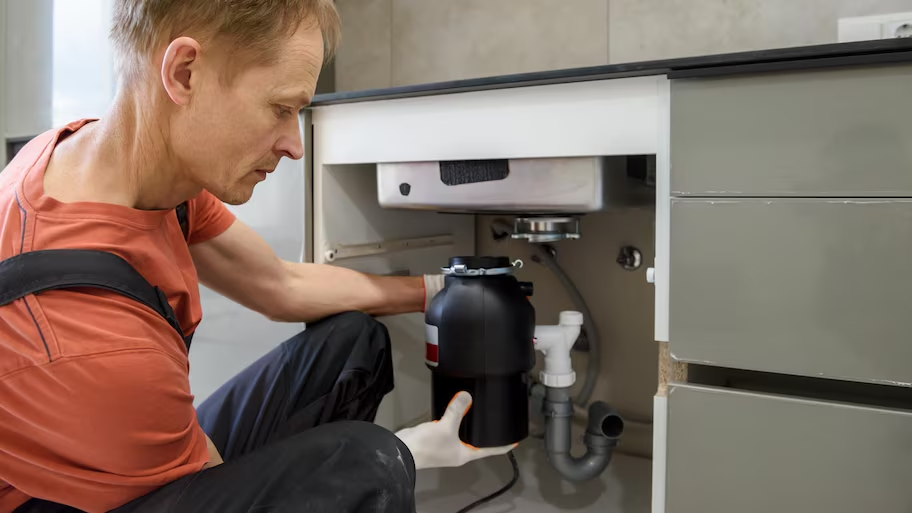Fast Solutions for Fixing a Dripping Waste Disposal Unit
Fast Solutions for Fixing a Dripping Waste Disposal Unit
Blog Article
Just how do you really feel in regards to Tips on Fixing a Leaking Garbage Disposal?

Garbage disposals are crucial cooking area devices that aid in disposing of food waste efficiently. Nonetheless, a leaking waste disposal unit can be a frustrating and untidy problem to deal with. Luckily, numerous leakages can be fixed quickly with a couple of simple actions. In this article, we will discuss how to take care of a dripping waste disposal unit successfully.
Introduction
Waste disposal unit are installed under cooking area sinks and are designed to shred food waste into smaller pieces, enabling it to travel through the pipes system quickly. While these tools are generally trustworthy, leakages can happen in time due to deterioration, loose links, or damage to the device.
Typical Root Causes Of Leaks in Waste Disposals
Worn Seals and Gaskets
Seals and gaskets play a vital role in preventing water from dripping out of the waste disposal unit. Gradually, these elements can wear away, causing leakages around the disposal unit.
Loose Connections
The links between the waste disposal unit and the plumbing system can come to be loosened with time, triggering water to leak out during operation.
Cracks or Holes in the Disposal System
Physical damages to the waste disposal unit, such as splits or openings in the real estate, can also lead to leaks.
Recognizing the Resource of the Leak
Prior to trying to fix a leaking garbage disposal, it is important to recognize the resource of the leak. This can typically be done through aesthetic inspection or by performing basic examinations.
Visual Assessment
Evaluate the garbage disposal unit thoroughly for any indications of water leakage. Pay attention to locations around seals, gaskets, and connection factors.
Evaluating for Leaks
One means to test for leakages is by running water through the disposal system and looking for any visible indicators of leak.
Tools and Products Needed for Fixing a Dripping Garbage Disposal
Before starting the fixing procedure, collect the required devices and materials, consisting of a screwdriver, flexible wrench, plumber's putty, substitute seals or gaskets, and epoxy or patching product for repairing splits or openings.
Step-by-Step Guide to Taking Care Of a Dripping Garbage Disposal
Turn Off the Power
Before attempting any type of repair services, make sure that the power to the waste disposal unit system is turned off to avoid the danger of electrical shock.
Locate the Leak
Determine the precise place of the leakage and determine the reason.
Tighten up Links
Utilize a wrench to tighten any type of loose links in between the disposal device and the plumbing system.
Replace Seals or Gaskets
If the leakage is because of worn seals or gaskets, remove the old parts and change them with new ones.
Patching Splits or Openings
For fractures or openings in the disposal unit, usage epoxy or an ideal patching material to secure the damaged location.
Checking the Garbage Disposal After Repair Work
Once the repair service is total, test the garbage disposal by running water via it to make sure that the leakage has been resolved.
Preventive Maintenance Tips to Prevent Future Leakages
To stop future leakages, it is necessary to do normal upkeep on your waste disposal unit. This consists of maintaining it clean, preventing putting non-food items or hard objects down the disposal, and periodically looking for leakages or other concerns.
Verdict
Finally, taking care of a dripping garbage disposal is a fairly uncomplicated process that can be finished with fundamental tools and materials. By complying with the actions detailed in this short article and exercising preventive maintenance, you can keep your garbage disposal in good working problem and avoid expensive fixings in the future.
HERE’S HOW TO FIX YOUR GARBAGE DISPOSAL
WHAT TO DO IF SOMETHING IS STUCK IN YOUR GARBAGE DISPOSAL
If the impeller won’t turn, there’s probably something stuck in the disposal. It could be a steak bone or peach pit, although plumbers report pulling all sorts of inappropriate objects out of disposals, such as bottle caps or aluminum foil. Make sure power to the disposal is off, and look inside to see if you can see the source of the jam.
Never stick your fingers in a disposal. Pull out anything you see with tongs or pliers.
If the disposal still won’t work, it may be time to call a plumber or consider buying a new disposal. GEM Plumbing & Heating is here for all of your garbage disposal needs.
WHAT TO DO IF YOUR GARBAGE DISPOSAL DRAIN IS CLOGGED
Take everything out from underneath your sink and put a bucket or other container under your disposal to catch any water that drains out. Disconnect your disposal from the power supply. If it’s plugged into a wall outlet, unplug it. If it’s hardwired into an electrical box, go to the electrical panel and turn off the breaker for the disposal. Pour ¼ cup of baking soda into the drain, followed by ½ cup of white vinegar. Give the solution a few minutes to fizz and do its work. Look into the disposal with a flashlight to see if you can see an object that might be causing the clog. If you see it, remove it using tongs or pliers. MORE TIPS ON DEALING WITH A CLOGGED GARBAGE DISPOSAL
Never use drain cleaner in a garbage disposal. It can damage the plastic parts inside the disposal. You can also be splashed with the caustic liquid while working to clear the clog. Beware! Never stick your fingers into a garbage disposal. Trust us — not a good idea. In many instances, your dishwasher drains through your garbage disposal. This allows the disposal to grind any large food particles that may be drained out of your dishwasher. There are some jurisdictions, however, where the plumbing code prohibits such a connection. WHAT TO DO WHEN YOUR DISHWASHER DRAINS THROUGH THE DISPOSAL
Run some water in the sink so your plunger has at least a ½-inch of water to create a seal and plunge vigorously up and down several times. You may need to repeat this several times. Run hot water down the drain to clear any residue that remains.

I discovered that article on Why Is when perusing the web. Sharing is caring. Helping people is fun. Many thanks for your time spent reading it.
Click Here Report this page